Flying
with the Fab 4
While working on a story about the long history of railroads
in the Milwaukee suburb of Brookfield where I live, a contact told
me I needed to talk with fellow resident and train maven Jerry
Hilton. Jerry, a retired business executive whose grandfather worked for the Great Northern Railway and helped stimulate Jerry's interest in railroading, is also a writer and had already published a story on the subject in the Milwaukee Road magazine.
When I contacted him, Jerry asked what kinds of things I had written. I mentioned several stories including one about The Beatles' appearance at the Milwaukee Arena in 1964.
He surprised me—to say the least—when he said his father had been on the flight with The Beatles during their first trip to America. "Wow!" I said. "Yeah," he continued, "and I have pictures of him with them."
I said "Wow!" again and, "Could I see the pictures?" He replied that he wasn't sure where they were but would let me know if he found them. "Great," I said.
Returning
from
England
Months went by, and after I finished my rail story and uploaded it, I e-mailed a link to Jerry. He had a favorable response and floored me a few days later when he sent scans of five black and white photographs of The Beatles. One showed Ringo Starr and George Harrison sitting in the second-from-last row of a jetliner with a distinguished-looking gentleman behind them.
Jerry explained: "That is my father, Henry M. Hilton, with the tie on. (I don't think any of The Beatles ever wore ties!) This was taken on the TWA flight that brought The Beatles to America the first time."
Clearly, Jerry, a charming man in his 70s, isn't a Beatles fan—the Fab 4 made it big after his teen years. He told me his father was born in 1903 and ran the Hilton Company, which was located in Butler, another Milwaukee suburb. "We manufactured aluminum products, including ladders and beer barrels," he said. Jerry was vice president of engineering and production. Hops grows next to his 1962 ranch home and commemorates his decades of involvement in the brewing industry.
"We also represented an American firm that developed a cold-mold casting process for aluminum," he continued, "which is one of the reasons my father flew to England. He was visiting a company called Alumasc, in Burton Latimer" (a town of 6,700 located 80 miles north of London1). "Alumasc made cast aluminum beer barrels and tapping systems. It was interested in the cold-mold casting process we represented, and we were interested in selling Alumasc tapping systems."
Asked if he was related to Paris Hilton, Jerry said, no, but added that the first Hilton in his family to immigrate to America arrived on the Fortune, "the second ship to land at Plymouth, after the Mayflower." I popped "fortune mayflower" into Google and, sure enough, the ship docked in Plymouth on November 9, 1621.2 The passenger list included William Hilton, who, another site records, hailed from London.3
August
13, 1965
I was pretty sure the photograph of George and Ringo sitting in front of Henry wasn't taken in 1964, an opinion shaped by Ringo's shirt, which looked to be in the style of later fashions, especially the unusual collar with its ring of symbols. In addition, a memory in the back of my head told me The Beatles flew Pan Am when they traveled to New York in 1964.
Meeting with the press was typical during the group's tours, so I searched Google for "Beatles news conferences" and found the "Beatles Ultimate Experience" website4; it has a database of Fab 4 press events. Soon I was at a page with a photograph of the group sitting behind microphones, and there's Ringo in the same shirt. The shot was taken August 13, 1965,5 at the Warwick Hotel in New York, so I now had the date of Henry's flight.
Fashion
digression
A shot by photographer Ken Regan on the JFK
tarmac indicates Ringo was even more the odd man out than depicted
in the black and white photograph. His suit is powder blue
and shirt, ocean blue, except for the collar, which appears to
include white and possibly other subtle hues. George is in a black
suit and blue dress shirt, John's wearing a light gray suit and
brown shirt, and Paul, a white shirt and pin-striped suit. Ringo's shirt is strikingly different from the open- and button-down-collar styles the others are wearing. It looks Indian, perhaps part of a trend that brought South Asian culture into the world of 60s pop, culminating in Ravi Shankar concerts and transcendental meditation. The decorations on the collar and cuffs might be star- or sunbursts.
Googling for an expert opinion, I found Mike Pretious, a lecturer in marketing, retailing, and consumer studies at Queen Margaret University, Edinburgh, Scotland. He was a buyer for many years and now gives talks on 60s fashions.
"The shirt appears to be a 'pullover' style," he responded by email, "with no buttons at the front...the embroidered pattern may be ethnic symbols, though I cannot recognize any particular Indian or other script."
Another Web find, Shaun Cole, course director of the History and Culture of Fashion at the London College of Fashion, replied: "...looking closely at the images it seems to me that the shirt could well be made from a woven rather than knitted fabric and so might be of the type that buttons at the side of the neck and across the shoulder that were beginning to be imported from Asia and fitted with the beginnings of an 'ethnic' influence in young men and women's fashions...It also appears to me that the 'pattern' around the neck is on a piece of ribbon or other form of embroidered textile..."
Woven fabrics tend to be tighter and more constraining, knits, looser; it's the difference between a woven dress shirt, and a knit golf shirt.
Guitarist-singer-writer-friend Howard Hinterhuer said the shirt might have a "mandarin"6 collar. The examples of mandarin-collared shirts I found online, however, either have a vertical opening just below the wearer's Adam's apple or a button. Neither is present on Ringo's shirt.
A website I encountered comments on the band's changing attire: "As The Beatles began to experiment with their music on Rubber Soul and Revolver, they also began to experiment with their clothes. Their days of touring were almost over and so were the matching suits. Turtlenecks replaced white dress shirts as the lads took a more casual approach to dressing."7 Ringo's shirt looks a little like a mock turtleneck, albeit a fancy one.
The Beatles flew to America that Friday the 13th on TWA Flight 7038 to begin their two-week, 1965 North American tour (one appearance was in Toronto). They opened in a big way two days later at Shea Stadium, where they wore matching tan suits with epaulets and what appear to be the mandarin collars Howard mentioned.
TWA
Trying to learn more about the flight and locate additional photographs of The Beatles aboard, I contacted the TWA Museum in Kansas City, where the airline's headquarters were located. TWA was founded in 1930, the result of a merger. Originally, the letters stood for "Transcontinental and Western Airlines."
Howard Hughes bought 25% of the company for $15 million in 1938,9 the name was changed to "Trans World Airlines" in 1950,10 and the company operated until 200111 when it was acquired by American Airlines.
Staff member Zana Allen, one of the museum's founders, gave me several leads, including a contact at the Kansas City Museum named David Boutous. Zana is a former "hostess," as TWA called its flight attendants in the '60s, a time when most airlines referred to them as "stewardesses." Although male stewards were employed in the early days of air travel, a Wikipedia entry states, "female flight attendants rapidly replaced male ones, and by 1936, they had all but taken over the role."12
Many thousands of images shot by TWA photographers and freelancers employed by the company exist, David said, "but unfortunately they reside in crates, file drawers, or boxes and haven't been sorted or indexed." No plans or budgets are in pace to do the work. It's a shame because probably there are many gems, including additional shots of The Beatles.
Zana also told me about a
TWA newsletter called Skyliner
that was published for employees beginning in 1932. "An
archive of the publication is online," she said, and it proved
to be a valuable resource.13
Skyliner article
A group of fans learned about the band's travel plans, the Skyliner article continues, and managed to buy coach seats: "Only a thin partition restrained 120 eager Beatlesnuts in the rear section who at the very least hoped to catch a glimpse of the famous group up front. In an effort to divert the attention of the newly formed airborne Beatle fan club, public relations representative Bill Liss employed the tactic of handing out autographed photos and Beatle record albums to the teenagers aboard. The ploy worked like a tranquilizer."15
The Beatles Bible website states the flight left London at "midday" and arrived in New York at 2:30 p.m. eastern standard time.16 Co-pilot Art Lorentz, whose nephew sent a reminiscence about his uncle's overseas trip with The Beatles, logged a time of "9 11" (nine hours, eleven minutes) for the flight.
Planning
for perfection
I was able to locate Bill Liss who recalled: "The trip was planned a good month in advance. I flew to England and spent some time with Brian Epstein who later died at just 32. I had some caricatures of The Beatles made that we put on the inside of the cabin door. They were autographed by each Beatle, and I believe I still have them somewhere in the attic. The crew was handpicked because TWA wanted everything to go well; the company chose people it was sure could handle taking care of the Beatles and coping with the crush of fans we knew would be along."
As the airliner approached New York the Skyliner article reports, "Captain Jack Hulburd opened a sealed envelope of instructions from the Port of New York Authority...The veteran pilot unfolded a detailed map...with eight possible parking points." Number 8, the pilot was informed, an area "two miles removed from the International Arrival Building," would be the place where the Beatles deplanded.17
"Hostess Gisa Kothe," the article concludes, "who is Miss New York Press Photographer and Queen of the Forest Hills Music Festival, first peered out to see if the coast was clear. As The Beatles braved their way out the door and deplaned, Paul McCartney turned to her and said: 'Thanks so much, luv, for a wonderful flight.'"18
Gisa
I was also able to locate Gisa, who retired from flying in 1967, married, and had two children. "TWA was often called 'the Airline of the Stars,'" she said, "and I had the opportunity to meet many celebrities, but none caused as much excitement as The Beatles."
Gisa wanted to work for an airline since she was a young girl: "It was a passion of mine; I read books about it! When I was old enough after college, I applied directly to TWA, mainly because it had a reputation for being an international carrier. I was born in Germany and wanted to travel to my home country now and then." She had to have been extra special. "Two hundred girls were interviewed, but only two of us were called back," she remembered.
When TWA telephoned, Gisa said she was: "Ecstatic! Flying was my dream so I was thrilled to get the job."
Becoming
an international TWA hostess
She trained for about nine weeks. "Safety was the primary topic, but we also were taught how to dress and apply makeup," she said. "In some ways, it was like a finishing school. Taking care of the food service properly was another focus. Training was challenging; not everyone made it."
Her first assignment was flying domestic routes out of New York City. After a few months, she transferred to the international division and particularly liked working the first-class section which she described as "a lot of fun." Air travel was a different experience in the 60s. "People got dressed up," she said. "Men wore suits and women, dresses. In the Ambassador Section, meals were served on fine China with tablecloths. Very classy. Today, it's a job to fly anywhere; back then it was a pleasurable experience."
She said she "flew all over the place" but particularly liked flights to Germany where many of her relatives lived.
Rested
and
ready
Gisa enjoyed Beatles music but recalled being more of a fan of Elvis Presley and Doris Day. She said "Love Me Tender" and "Que Sera Sera" were favorites. Today she still likes Paul McCartney songs.
It's been a long time, but she believes the crew for The Beatles flight "deadheaded" (traveled as passengers for logistical reasons19) to London because "management wanted to be sure it had the best." She and other personnel, including the captain and copilot, arrived a day ahead of time so everyone was well rested. Otherwise there weren't any special preparations. "We always represented TWA to the best of our ability—we were professionals, so we just gave the band our usual," she said.
Flying on Friday the 13th didn't bother her as she was "never superstitious," although she said she was aware that some airlines didn't (and still don't) use the number 13 to mark rows in their planes, an oddity I never noticed.
The jet that carried The Beatles was a Boeing 70720 which she flew many times.
Another hostess worked first class with Gisa along with Purser Ed Bauer. (According to a Wikipedia entry, a purser is "...the cabin manager [chief flight attendant]...The purser oversees the flight attendants making sure airline passengers are safe and comfortable."21)
"One
of whom passed out cigars"
Gisa's parents lived in East Hartland, Connecticut, and The
Hartford Courant
published a story on November 21, 1965, about her
flight with the band. The article reports that
Beatles manager Brian Epstein, his secretary, Wendy Hansen, and
two of the band's road managers were also in the first-class
section. Five other passengers are listed: "...a college professor
and his wife...and three businessmen, one of whom passed out
cigars."22
I asked Jerry if his dad smoked cigars: "No more than 14 per day," he replied. "His favorite was 'top quality throw-outs,' i.e. cheap seconds! My mother called them 'foul, stinking weeds.' That I agree was quite accurate. He never was allowed to smoke in their house."
Smoking
section
It's likely Henry, a successful businessman, booked his first-class seat well in advance, and because he was a smoker, it's understandable he was in the last row of the section with George, John, Paul, and Ringo—all smokers at the time—just in front of him. Smoking was permitted on most flights in the 60s, and smoking sections typically were in the rear of the coach and first-class cabins.
Jerry's father talked with the group during the flight and told family members The Beatles were friendly and unassuming. Ringo even spilled coffee on Henry and was apologetic. United Press International distributed a story about The Beatles' flight and arrival in America, versions of which were printed in various newspapers, including The Milwaukee Sentinel, which detailed Henry's reaction: "'I didn't mind it,' he said, 'it was just a little bit of coffee. They (The Beatles) were very nice guys. I was very impressed with them. They walked around the first class section, smoked, had a few drinks, and talked with some of the other passengers.'"23
A Sentinel
reporter contacted the family in Wauwatosa, spoke with Henry's
wife, Alice, and quoted her in the local story: "'Though our
three-year-old granddaughter dances to The Beatles records, we
just laugh at the group,' Mrs. Hilton said here when notified of
her husband's mishap."24
Apprised of her Uncle Henry's liquid interaction with the Fab 4's drummer, a teenaged niece wanted his coat. "Dad thought that was ridiculous and refused," Jerry laughed.
Observations
and mementos
"Paul was the cutest," Gisa said, "and my recollection is vague but they ate very little and drank soft drinks." The Hartford Courant article quotes her as saying: "They were very reserved during the flight." Reporter Steve Nidetz added: "Besides eating chateaubriand, lobster, and cheese and crackers with wine (George's favorite), the fearless foursome occupied its time playing games (Paul won the navigation game), drinking champagne, and watching a movie."
Gisa said crew members, for the most part, did not take advantage of the situation by soliciting autographs or other mementos. Without asking, however, she was given two "treasures," as she termed them: a just-pressed 45 of "Help," with first names signed on the sleeve by each Beatle and an 8" x 10" black and white glossy of the group with full signatures. (Gisa has stored these carefully and securely in a safety deposit box.) A photo in the Skyliner story also shows the flight's purser with a group of kids vying for Beatles souvenirs, including a wash cloth, he collected on the flight.
In addition, PR man Bill, fulfilled the fervent wishes of two Missouri girls: Ruth, the daughter of a TWA supervisor who worked in the airline's Kansas City training center, and the daughter of Robert Helmer, who Bill said was "head of TWA public relations." Ruth sent Bill a stamped, self-addressed envelope, and he asked each Beatle to sign it on the back. (Click for a scan of the autographs and more details, including how the story came to my attention.)
The autographs Bill secured for the second daughter were later purchased by Ray E., a buyer and seller of memorabilia. (Click for images and Ray's account of how he came to own the autographs and related items).
Just
fellow travelers
One of the things that attracted me to this story was the peculiar situation that existed on the jetliner with Jerry's dad and The Beatles. Henry Hilton, who was 62 at the time, wasn't a Beatles fan, and in fact, Jerry told me, "Dad wasn't a fan of any music, really."
So, for The Beatles he was just a fellow traveler, not someone who fawned over them or tripped over himself in an attempt to be cool in their "toppermost-of-the-poppermost" presence. Certainly they met other people like Henry, and I have a feeling it was always refreshing. Despite their cosmic success and fame, they could relate to Henry, probably in the same way they related to family members and friends they had known since before Beatlemania.
Stars
and VIPS
Other notables who flew in Gisa's section included Rex Harrison, Patricia Neal, Geraldine Chaplin, Twiggy, and Elizabeth Taylor's sons Michael and Christopher, whom she called the "Wilding boys." "Paul Newman would pay for three seats in coach so he could stretch out and sleep during cross-Atlantic flights," Gisa said.
But nothing compared to John, George, Paul, and Ringo: "The energy on the airplane was positively electric; every time the curtain to the Ambassador Section opened, many heads bobbed up in coach, and many pairs of eyes strained to get a glimpse of our special passengers. The Beatles were kind, sociable gentlemen, who interacted with me like any other normal, nice people would. I remember complimenting John on his sunglasses but don't remember what was special about them."
Interviewed by The Harford Courant just a few months after the flight, her memory was fresher: "Throughout the trip, John wore a pair of 'wild sunglasses that looked like mirrors,' Miss Kothe said. 'But when I asked him to try them on, he said, 'No, I'm sorry, maybe next time.'"25
"Lennon
lemon acid"
John's reaction comports with the picture painted of him in Elvis Meets The Beatles by Chris Hutchins and Peter Thompson. The authors relate various examples of his unfriendly, even cruel behavior, including an incident that occurred in Las Vegas during their 1964 tour:
"I (Chris) was enjoying a drink with the group at the Sands Hotel when a bespectacled teenage girl, not the usual Beatles groupie, burst in unannounced. We were trying to work out how she had managed to slip past the security guards when she explained in a loud, friendly voice: 'Hi, guys! I'm Donald O'Connor's daughter.' John did not hesitate. Eyes narrowing, he looked up and said: 'Oh, I'm sorry, luv, I really am.' Puzzled, Donald O'Connor's daughter said: 'Whadda ya mean, you're sorry?' 'Just heard it on the radio,' replied John, straight-faced. 'Your dad's dead.' Donald O'Connor's daughter reeled beneath this dose of what we called the 'Lennon lemon acid.' She broke down in hysterics and had to be sedated. The last I saw of her, she was being driven away in an ambulance."26
Donald O'Connor had a daughter named Donna Gwen who was born in 1946 and would have been 17 or 18 in 1964.27 Her father actually lived until 2003.
The book recounts other examples of John's nasty side, including one involving Jayne Mansfield. Quite a surprise for the "All You Need Is Love" guy and staunch peacenik, a position he had already taken by the 1965 tour.
Food
fight
PR representative Bill Liss was also on the flight: "Paul was very quiet, and Ringo, relatively effusive. Paul was doing some writing, and I sat next to him for a while. All four were polite; George was particularly friendly."
Bill remembered that Brian Epstein sat forward of the band but couldn't recall anything about him other than that he was "sort of the monitor and kept everyone in tow." This didn't prevent band members from engaging in a food fight. "Ringo started it," Bill remembered, "then everyone joined in--they were slinging food at one another."
TWA-Beatles
flight
bags
Bill also coordinated production of the special TWA-Beatles flight bags that were given to the group, members of their entourage, and other VIPs. He said that when the Beatles first traveled to America in 1964, they flew on Pan-Am and were pictured getting off the plane carrying Pam-Am flight bags. "We wanted to take advantage of the situation like Pan-Am did so we had special bags made."
The group and the people traveling with them were, "Not the least bit taken with themselves," Bill recalled. "They were good, decent people, and truly there wasn't anything unusual about them. Very unpretentious."
Hits
in the making
Bill overheard bits of conversation the four exchanged and his memory is that they were mainly about music, not surprisingly. Help!, the band's second movie, had premiered in the UK on July 2928 and opened in the US just two days before the flight.29 Soundtrack albums came out about the same time.30
Their next LP, Rubber Soul was released four months later31 and included "Drive My Car," "Nowhere Man," and "Norwegian Wood (This Bird Has Flown)." The latter featured what is said to be the first use of the sitar in a Western pop song.32 Hits that would appear on Rubber Soul might already have been forming in the minds of John, Paul, George, and Ringo and surfacing in their discussions aboard Flight 703.
Irritated
passengers
The Lima
News version of the UPI story about The Beatles' flight
and arrival in New York includes, "the plane landed at Kennedy
International Airport and taxied to a secluded section about two
miles from the main terminal..."33
The delay upset some passengers as evidenced by a Henry
Hilton remark that appeared in the story: "...I
heard one fellow seated in the economy section say, 'This is a
damn outrage...all this attention being paid to four
screwballs.'"34 Disparaging
characterizations of The Beatles by "grownups" were typical in
the mid-sixties, at least in America. Even journalists and
critics often wrote about the band using insect metaphors.
Few identified "beat"
as the root of the name. Snide
comments about their hair were also common.Unappreciative
press
In my first Beatles story, I
quoted Milwaukee Journal
columnist Gerald Kloss' recap
of their September 4, 1964 concert at the Milwaukee Arena. He referred
to them as "bushy haired intruders from Liverpool" and added,
"So here they were at last, almost within falling dandruff
distance and they looked even more cuddly than they had on The
Ed Sullivan TV shows."35Newsweek, then a major American weekly, published a cover story called "Bugs About Beatles" in the February 24, 1964 issue. Though the article accurately describes the origin of the band's name, the title conveys the standard arthropodal connotations. The story itself opens scathingly: "Visually they are a nightmare: tight, dandified, Edwardian-Beatnik suits and great pudding bowls of hair. Musically they are a near-disaster: guitars and drums slamming out a merciless beat that does away with secondary rhythms, harmony, and melody. Their lyrics (punctuated by nutty shouts of 'yeah, yeah, yeah!') are a catastrophe, a preposterous farrago of Valentine-card romantic sentiments."36 Crude appraisals such as these were not unusual when The Beatles first appeared in America. Fifty years later it's hard to imagine how different they were from what was normal in an era dominated by The Beach Boys, Bobby Darin, The Four Seasons, and similar pop acts.
Changes
I was a 13-year-old living in Janesville, Wisconsin, in January, 1964, when The Beatles' first American Top 40 hit, "I Want To Hold Your Hand," began playing on WLS-Chicago, the only station I knew of back then that broadcast rock and roll. (Evidently, "Please, Please, Me" was on WLS in March of 1963,37 but it didn't make much of a splash, and I don't remember it.)
On a Friday night at about that time, I attended the Marshall Junior High School seventh-grade dance and won a raffled gift certificate worth $1.00 at Dorothy's Record Shop, located on Janesville's Main Street. A 45 rpm single could be had for that price, so I visited the store the next day with a bunch of friends and got "I Want To Hold Your Hand," with "I Saw Her Standing There" on the "B" side. My family didn't have a record player but that didn't stop me.
My buddies and I returned to my parents' small cape cod, gathered in the basement, and passed around the record still in its sleeve, which featured a black and white photo of the band. My memory is this was before The Beatles made their widely viewed first appearance on The Ed Sullivan Show in February, 1964. We all liked Beatles' music, but each of us in turn made rude, teenage-boy comments about how ugly John, Paul, George, and Ringo were. Seems impossible now, but all of us back then had short, Brycreemed, Vitalised, or Wildrooted hair that was combed back to look something like the way Elvis Presley, Edd Byrnes, Fabian, and a long list of other TV, movie, or rock and roll stars wore theirs.
It didn't take long for us to abandon our previous understanding of what was cool!
By July, 1964, when the first Beatles' movie, A Hard Day's Night, was released, my friends and I went to see the film on its opening night at Jeffris Theater and by then we were all wearing long, dry, combed-down Beatle cuts.
The same sort of metamorphosis was visible across America. The dancers on Dick Clark's American Bandstand quickly went from looking something like Bobby Rydell and Leslie Gore to mimicking the fashions of early British Invasion troops such as The Beatles; Dave Clark Five; Gerry and the Pacemakers; Peter and Gordon; the many slinky, Carnaby-Street-attired women band members were pictured with; and the occasional female English pop singer such as Cilla Black.
(Ultimately, I gave the "I Want To Hold Your Hand"/"I Saw Her Standing There" 45 to an early unrequited love named Kristy and have sometimes wondered whether she still has it and remembers where she got it.)
As TWA Flight 703 eased to a halt at a remote spot on the JFK tarmac, just over 18 months had passed since The Beatles began dominating American Top 40 AM radio airwaves. Nevertheless, the transition among the young to "My Generation" sensibilities of what looked and sounded hip was nearly complete.
Fans
at the gate
"When The Beatles deplaned," Gisa recalled, "they were whisked away, and we taxied to the terminal where the other passengers disembarked. The terminal was an absolute mob scene of wild, screaming teenagers awaiting the arrival of their idols—of course, by then, the Beatles were already well on their way into the city. The next best thing was the crew, so we were mobbed and even asked for autographs." The San Antonio Light also picked up the UPI story and reported, "...an estimated 250 teenagers waited to greet the singers."38
Gisa thinks she gave five or ten autographs, and, maybe, somewhere, someone still has one in a frame, a cherished memento signed by a hostess who had just flown across the Atlantic with the ultimate pop stars of the swinging sixties.
After their arrival, "The Beatles were driven straight to the Warwick Hotel on 6th Avenue and 54th Street," reports the Beatles Bible website, "where they stayed on until 17 August. They gave a press conference, directed by their press officer Tony Barrow, for around 250 reporters. The group had the entire 33rd floor of the Warwick Hotel to themselves..."39
Busy
weekend
On Saturday they visited CBS-TV Studio 50 for an Ed Sullivan Show appearance, beginning rehearsals at 11:00 a.m. and taping six songs ("I Feel Fine," "I'm Down," "Act Naturally," "Ticket To Ride," "Yesterday," and "Help") at 8:30 p.m. in front of 700.40
Sunday evening, August 15, they played Shea Stadium before the largest audience ever assembled for a rock and roll concert up until that time. Some 55,600 fans attended; gross revenues were $304,000 and the group's share was $160,000,41 which is comparable to more than $1.1 million in today's dollars.42
It was a huge crowd, but far short of an overall record. Eight years earlier, for example, on July 21, 1957, the Reverend Billy Graham drew 100,000 to Yankee Stadium, "the largest crowd in stadium history," a New York Times website reports.43
Vice President Richard M. Nixon was on the platform with the reverend, who lauded Nixon as "one of the hardest working men in the United States"; his country's "ambassador of goodwill, a young man with vision, integrity and courage."44
On the East River
Rolling
the Stones
Keith and Mick were present when the band was introduced: "Ed Sullivan," writes Chris, "compere for the event, announced: 'Now, ladies and gentlemen, honored by their country, decorated by their queen, and loved here in America: Here are The Beatles!' If the stadium had had a roof, it would have been blown sky-high. Never have I heard such a blast. The screaming, shouting, whistling, and stomping swelled into a crescendo that sent me and the Stones reeling backwards in the aisle. The Beatles had literally rolled the Stones."47
It's hard to imagine anyone heard much over the screaming fans. "Back at the hotel after the concert," Chris continues, "George said: 'I've never felt so exhilarated in my life...it was unbelievable that so many people wanted to see us.' Added John, 'It would have been better still if we could have heard what we were playing. I wasn't sure what key I was in on two numbers.'"48
(Note: Eight weeks earlier, on June 20, The Beatles played two concerts in Paris. Video of one of the shows is available on You Tube. Fans at this appearance were comparatively reserved, and it's possible to hear how the group sounded live in 1965.)
The New York Journal American afternooon newspaper, now defunct but fairly popular in 1965, had a number of condescending, deprecating, and sensational stories about the band, its arrival in the Big Apple, and the Shea concert. I've excerpted some here.
The Beatles played nine more concerts during their North American tour, culminating in three California performances, including shows in LA on August 29 and 30.49
Jamming
with Elvis
While in the Golden State they visited Elvis Presley on
Friday night, August 27.50
He was in LA finishing work on his latest film, Paradise
Hawaiian Style, which was released in 1966.51
Events leading to the band's time with the King in his
Bel-Air residence and the jam session that ensued are detailed in
Elvis Meets The Beatles,
which also includes interesting insights into the personalities of
wife Priscilla and manager Colonel Tom Parker. Elvis comes across as the true southern gentleman his parents raised him to be—down to earth, friendly, and genuinely interested in The Beatles. He recognized their talent. Clearly he was bothered by how the updated rock and roll the band and other British Invasion groups played was leaving him behind. Just 30, Elvis was obsolete—at least in terms of teens and young adults. He knew it and didn't like it.
Vietnam
Some friction occurred that evening between Elvis and John
due to the former's nationalism and
the latter's pacifism. Elvis was a vet and had rode a tank
while serving in Germany.52
About two weeks earlier, on July 28, President Lyndon Baines Johnson approved sending an additional 44 combat battalions to Vietnam bringing the total to 62.53 (By December, 1965, nearly 200,000 US troops were in the country.54) As he walked around Elvis' living room, John encountered a model of a covered wagon with lighted words on the side that proclaimed, "All the way with LBJ," the 36th president's 1964 campaign slogan.
"John frowned," Chris writes. "To John, LBJ was a warmonger responsible for the slaughter of innocent civilians in what he regarded as a civil war between the Vietnamese people. John's mood could change in an instant, and that is exactly what happened at Elvis Presley's party that night."55
Equals
He didn't say anything about the war or LBJ, but when Elvis told him he was "making movies at a million bucks a time and 'one of 'em—I won't say which one—took only fifteen days to complete.'" John quipped, "Well, we've got an hour to spare now...let's make an epic together."56 The King wasn't used to people making fun of him.
"I would classify that crack from John as the final insult," writes Chris who believes from that moment on, Elvis launched a vendetta primarily against John but also the other Beatles that ultimately led him to condemn the band during discussions with President Nixon and the FBI.
Strange
meetings
Elvis' time with Nixon was recounted in a December, 1970,
memo for the "President's file" written by administration official
Egil "Bud" Krogh. It stated that Elvis "indicated that he
thought The Beatles had been a real force for anti-American
spirit."57 Not long after, in January, 1971, Elvis met with the FBI. A memorandum by bureau officer M.A. Jones says he "indicated that he is of the opinion that The Beatles laid the groundwork for many of the problems we are having with young people by their filthy unkempt appearances and suggestive music..."58
Astonishing stuff. Right-wing, nationalistic, typical-of-the-"silent-majority" stuff. The kind of slander that was expected from Spiro Agnew and Merle Haggard but not from the King of Rock and Roll. Probably as much as his enlistment in the U.S. Army, it reveals how his early rebel persona was just an act and how well-suited he was to the carnival marketing genius of Colonel Tom Parker.
It also is indicative, perhaps, of a mind already deeply wounded by pharmaceuticals, self-imposed isolation, endless adoration, gargantuan financial resources, and his manager's exploitative though lucrative money-making schemes.
Into
the abyss
Just six years after his meeting with the FBI, on August 16, 1977, Elvis was found dead in his bathroom. The Medical Bag website reports: "The coroner recorded the cause of death as cardiac arrhythmia, a condition that can be determined only in someone who is still alive. This has caused claims of a cover-up. What was not recorded was Elvis’ addiction to the drugs codeine, Valium, morphine, and Demerol, just to name a few. While Presley’s main physician, Dr. George Nichopoulos, was exonerated of criminal liability for the singer’s death, the facts were startling. The Tennessee Medical Board, which investigated the case, found that Nichopoulos had prescribed Presley more than 10,000 doses of narcotics, amphetamines, and sedatives, and that was just in the first eight months of 1977. The medical board suspended Nichopoulos for three months and in 1995 his license was permanently revoked."59
I tried to obtain copies of the Tennessee Medical Board reports, but Blake Fontenay, communications director for the state of Tennessee replied in an e-mail, "Nashville had a very bad flood in 2010 and all of our archived records were destroyed..."
Two other sources report the same facts about Elvis' demise that are detailed on the Medical Bag website: a white paper titled "When Prescribing Psychotropic Drugs Becomes Criminal Negligence: Cases And Convictions," published by the Citizens Commission of Human Rights International60 and "Dr. Nick...Medically Irresponsible or Misunderstood?" at the Elvis Information Network.61
It's appalling that Elvis, despite his towering talent, allowed himself to slide so deeply into a chemical and ego-centric abyss, from which there would be no escape—starlight trapped in a black hole. Many pop stars consume illicit and licit drugs and cope with fame responsibly, but for some there is only decline, misery, and death. It's the mystery train on its way to the final station; it's David Bowie's "Always Crashing in the Same Car."
Ironically, in 1973, Elvis recorded "Good Time Charlie's Got The Blues,"62 by Danny O'Keefe, but omitted the third verse:
"I've got my pills to ease the pain
Can't find a thing to ease the rain
I'd love to try and settle down
But everybody's leaving town."63
And he didn't heed the advice in the second verse:
"You know my heart keeps tellin' me
You're not a kid at thirty-three
You play around you lose your wife,
You play too long, you lose your life."64
Paul's
memory of Elvis
When Paul eulogized John during his Beatles songwriting
partner's induction into the Rock and Roll Hall of Fame as a solo
performer on January 19, 1994,65 this is all he said
about the group's get-together with Elvis nearly 30 years earlier:
"...we met up with Elvis Presley for one great evening. We
saw the boy, you know, we saw him on his own home territory. He
was the first person I ever saw with a remote control on a
TV. Boy, he was a hero, man."66 In May of 2013, Paul visited Elvis' grave while in Memphis for an appearance and left a personalized guitar pick.67
Life
goes on
Henry Hilton, after his momentous but largely unheralded—especially
by him—trip across the Atlantic with
John, Paul, George, and Ringo, lived another 32 years, dying at
94, in 1997. What counted to him was his family; his
company; his hobbies, including building rustic outdoor furniture
and fishing; and his cigars, which, along with his entrepreneurial
success, put him one row behind the Fab 4 for nine
hours. He probably never knew that just a day after his journey with The Beatles on TWA Flight 703, they taped an Ed Sullivan appearance that was broadcast on Sunday, September 12, 1965, and viewed by more than 47 million.68
And most likely he was unaware they played to the largest audience ever gathered for a rock and roll concert to that date just 48 hours afterward and met with the genre's previous monarch two weeks later.
Odds are, he wouldn't have cared anyway; he had much more important things to think about and do.
Footnotes
1. http://en.wikipedia.org/wiki/Burton_Latimer
2. http://familysearch.50megs.com/SHIPS.htm
3.
http://www.alden.org/documents/otherships.htm
4. http://www.beatlesinterviews.org/5. http://www.beatlesinterviews.org/db1965.0813.beatles.html
6. http://en.wikipedia.org/wiki/Mandarin_collar
7. http://www.fashionwindows.com/fashion_review/1999/beatles.asp
8. Elvis Meets The Beatles, Chris Hutchins and Peter Thompson, 1994. Google
ePub edition. Page 154.
9. http://en.wikipedia.org/wiki/Trans_World_Airlines
10. http://traveltips.usatoday.com/twa-airlines-history-21998.html
11. http://en.wikipedia.org/wiki/Trans_World_Airlines
12. http://en.wikipedia.org/wiki/Flight_attendant
13. http://www.umkc.edu/whmckc/twa/twaskyliner.htm
14. TWA Skyliner August 30, 1965, page 2. "Beatlemania Aboard 703 Beats 007
Adventures."
15. Ibid.
16. http://www.beatlesbible.com/1965/08/13/travel-london-new-york/
17. TWA Skyliner August 30, 1965, page 2. "Beatlemania Aboard 703 Beats
007 Adventures."
18. Ibid.
19. http://en.wikipedia.org/wiki/Deadheading
20. http://en.wikipedia.org/wiki/Boeing_707
21. http://en.wikipedia.org/wiki/Purser
22. The Harford Courant, November 21, 1965, page 4G.
23. The Milwaukee Sentinel, August 14, 1965, page 7.
24. Ibid.
25. The Harford Courant, November 21, 1965, page 4G.
26. Elvis Meets The Beatles, Chris Hutchins and Peter Thompson, 1994. Google
ePub edition. Pages 115 and 116.
27. http://www.imdb.com/name/nm0640307/bio
28. The Complete Beatles Chronicle, Mark Lewissohn, 2010.Chicago Review
Press. Page 198.
29. http://www.classicbands.com/beatles.html
30. http://en.wikipedia.org/wiki/The_Beatles_discography
31. Ibid.
32. http://en.wikipedia.org/wiki/Sitar_in_popular_music
33. The Lima News, August 15, 1965, page 1.
34. Ibid.
35. The Milwaukee Journal, September 5, 1964.
36. Newsweek, "Bugs About Beatles," February 24, 1964.
37. http://www.users.qwest.net/~oldiesloon/wls030863.htm
38. The San Antonio Light, August 14, 1965, page 2.
39. http://www.beatlesbible.com/1965/08/13/travel-london-new-york/
40. The Complete Beatles Chronicle, Mark Lewissohn, Chicago Review Press 2010.
Pages 198, 199.
41. Ibid. Page 199.
42. http://www.dollartimes.com/calculators/inflation.htm
43. http://www.nytimes.com/books/97/07/06/reviews/graham-yankee.html
44. Ibid.
45. Elvis
Meets The Beatles, Chris Hutchins and Peter Thompson,
1994. Google
ePub edition. Page 159.47. Elvis
Meets The Beatles, Chris Hutchins and Peter Thompson,
1994 Google
ePub edition. Page 160.
48. Ibid.ePub edition. Page 160.
49. http://en.wikipedia.org/wiki/The_Beatles%27_1965_US_tour
50. Elvis
Meets The Beatles, Chris Hutchins and Peter Thompson,
1994 Google
ePub edition. Page 178.
51. http://en.wikipedia.org/wiki/Elvis_Presley_filmographyePub edition. Page 178.
52. http://www.funtrivia.com/askft/Question44681.html
53. Vietnam: A History, Stanley Karnow, The Viking Press, New York. Page 680.
54. Ibid.
55. Elvis
Meets The Beatles, Chris Hutchins and Peter Thompson
1994 Google
ePub edition. Page 183.
56. Ibid.
57. Ibid. Page 239.ePub edition. Page 183.
56. Ibid.
58. Ibid. Page 241.
59. http://www.themedicalbag.com/story/elvis-presley
60.
http://www.cchr.org/sites/default/files/Criminal_Negligence_White_Paper.pdf.
Page 6.
61. http://www.elvisinfonet.com/spotlight_drnick.htmPage 6.
62. http://www.youtube.com/watch?v=-YP3pIPp8P8
63.http://www.lyricsfreak.com/d/danny+okeefe/good+time+charlies+got+the+blues_
20204381.html
64. Ibid.20204381.html
65. http://rockhall.com/inductees/ceremonies/
66. http://www.youtube.com/watch?v=YDChVcLWpGc
67. http://music.yahoo.com/news/paul-mccartney-leaves-guitar-pick-elvis-presleys-
grave-120512967-rolling-stone.html
68. http://www.thefab40.com/ratingspr.html
* * *
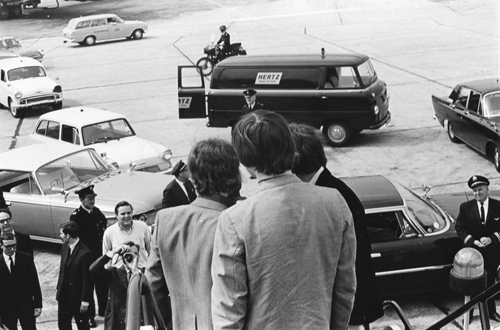
John, Ringo, and probably George Boarding TWA Flight 703
in London. Courtesy of Jerrold F. Hilton.
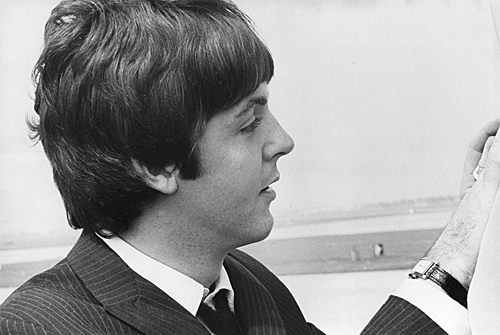
Paul boarding TWA Flight 703 in London.
Courtesy of Jerrold F. Hilton.
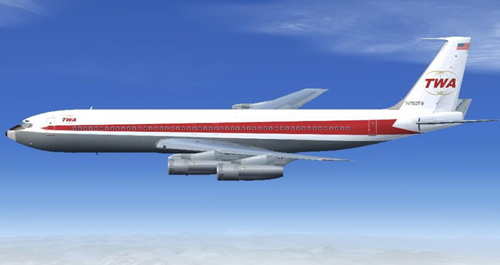
TWA Boeing 707 similar to the one that transported The Beatles.
Copyright owner unknown; found at http://www.aviationexplorer.com/
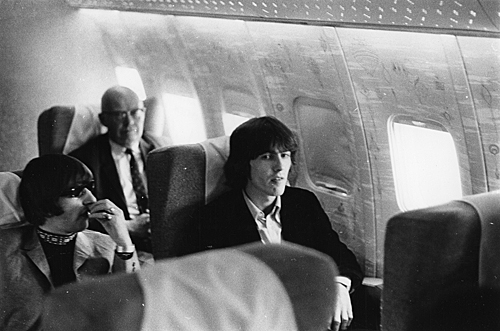
Henry M. Hilton in the last row of the Royal Ambassador section
on TWA Flight 703. Courtesy of Jerrold F. Hilton.
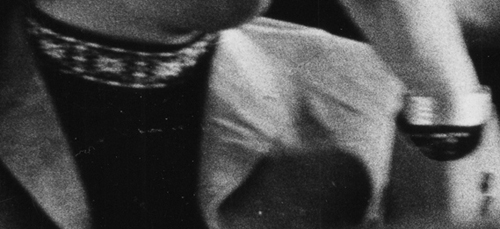
Collar and cuff of Ringo's shirt. Courtesy of Jerrold F. Hilton.
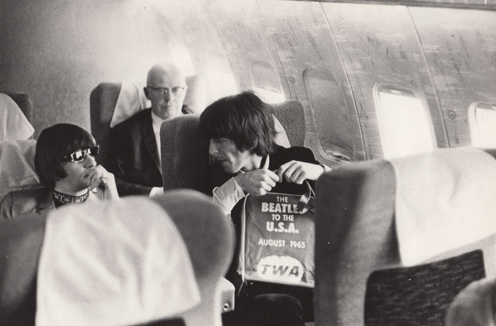
Courtesy of Ray E.
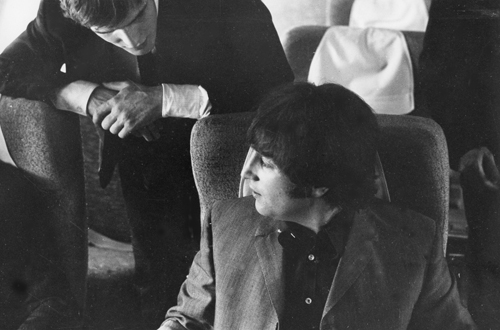
John and unidentified assistant, possibly Neil Aspinall
or Derek Taylor. Courtesy of Jerrold F. Hilton.
 Aboard
TWA
Flight 703.
Courtesy
of
Jerrold
F. Hilton.
Aboard
TWA
Flight 703.
Courtesy
of
Jerrold
F. Hilton.
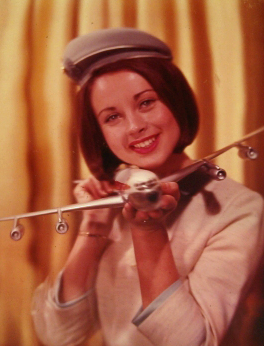
TWA Hostess Gisa. Courtesy of Gisa.
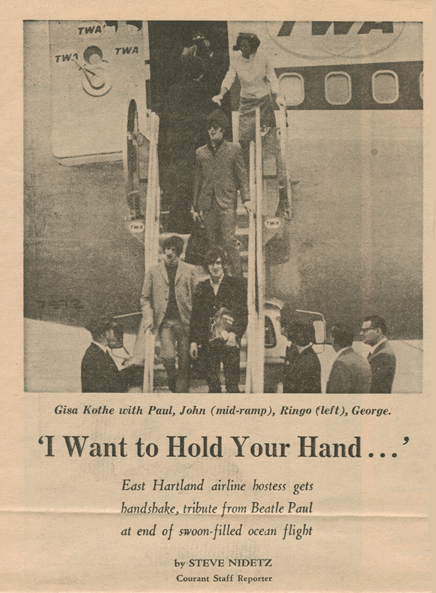
Courtesy of the Hartford Courant and Gisa.
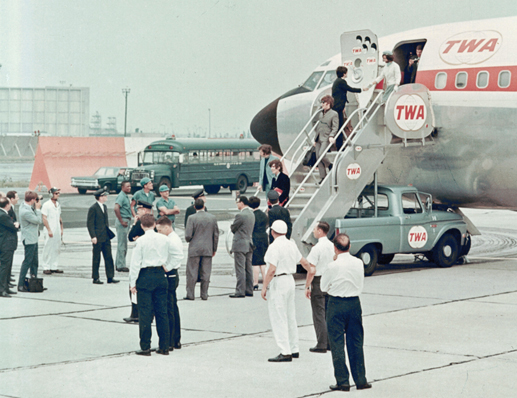
Shaking Gisa's hand as the Beatles deplaned TWA Flight 703, Paul said,
"Thanks so much, luv, for a wonderful flight." Snapshot courtesy of Gisa.
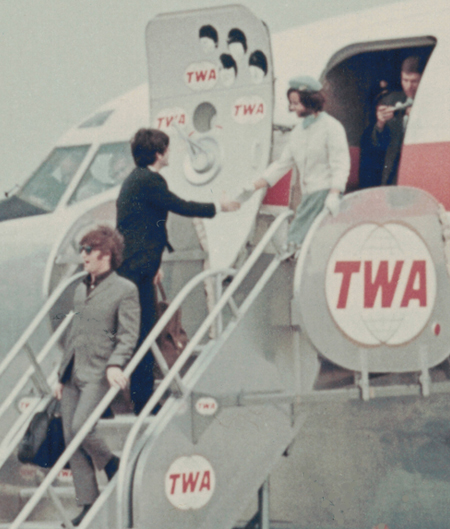
Closer view; note autographed caricatures on inner door. TWA
PR representative Bill Liss is standing in the doorway holding
a Kodak Retina II camera. Snapshot courtesy of Gisa.
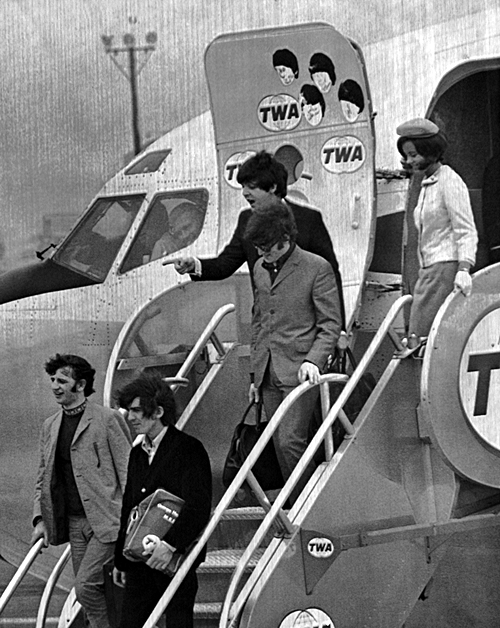
Another view. Courtesy of the Associated Press.

Detail showing caricatures commissioned by PR Representative Bill Liss and
placed on the inner panel of the cabin door. Courtesy of the Associated Press.
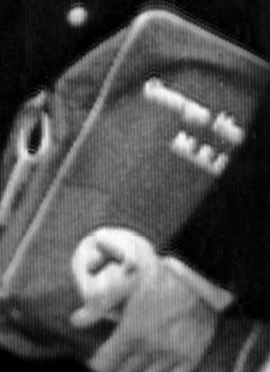
Blow-up of George's hand on one of the special flight bags (below)
commissioned by TWA for the occasion. The printing near the top
reads "George Harrison" on the first line and "MBE" (Member of the Order
of the British Empire) on the second. Each of the Beatles received the
MBE award on Queen Elizabeth's birthday in June, 1965.
Courtesy of the Associated Press.
Note: The Antiques Roadshow program (Charleston, West Virginia,
Hour 3) that originally aired on May 25, 2015, includes a segment
on the 1965 TWA Beatles flight bags. Click here to view it.
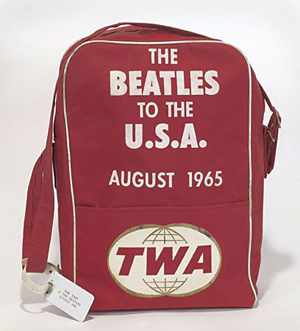
Flight bag commissioned by TWA to commemorate
the Beatles' flight. Courtesy of Legendary Auctions.
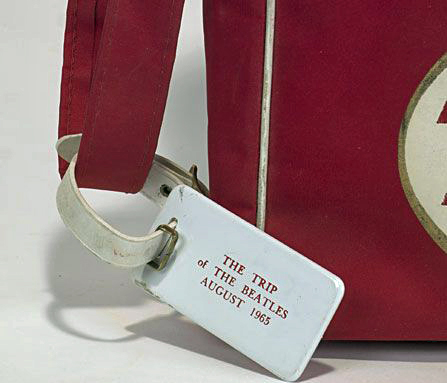
Courtesy of Legendary Auctions http://www.legendaryauctions.com
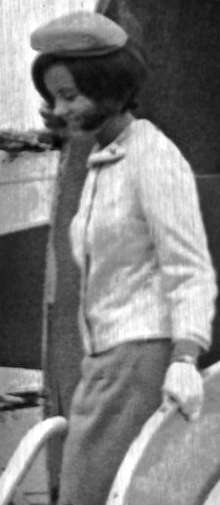
Hostess Gisa. Courtesy of the Associated Press.
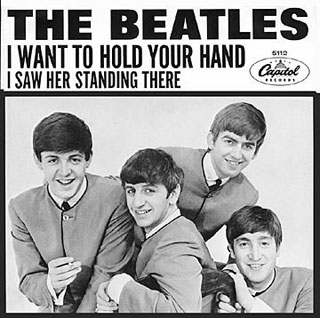
Sleeve of The Beatles' first American hit.
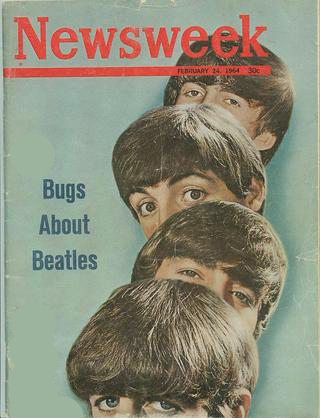
February 24, 1964.
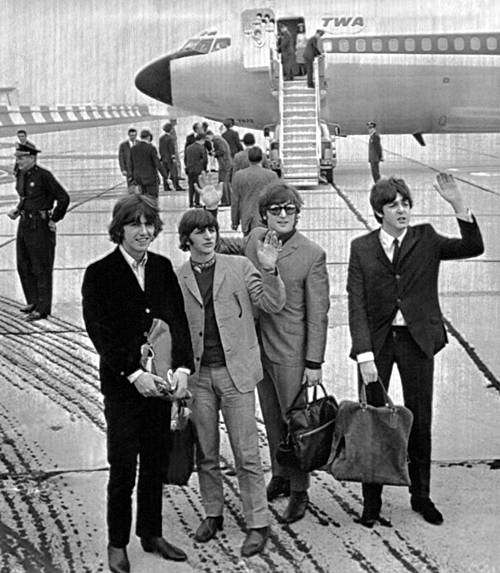
JFK International Airport tarmac. John's wearing the mirrored shades that
Hostess Gisa, visible at the top of the passenger boarding stairs, asked him
about. All but Paul appear to be wearing so-called Beatle boots.
Courtesy of the Associated Press.
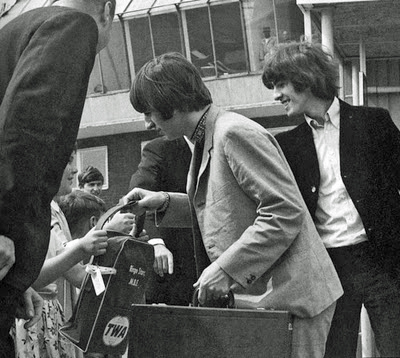
JFK International Airport.
Found at http://meetthebeatlesforreal.blogspot.com/
Copyright owner unknown.
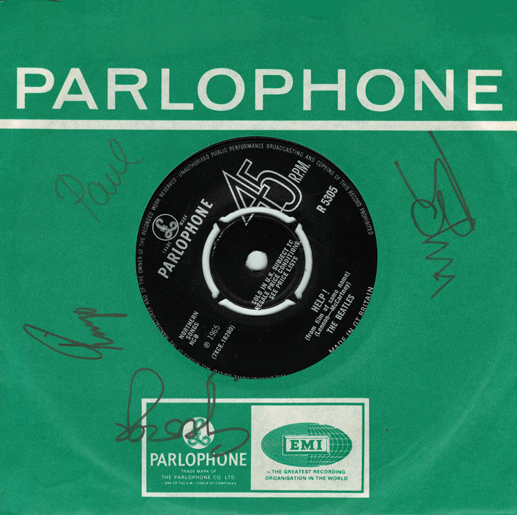
Autographed 45 given to Gisa during the flight.
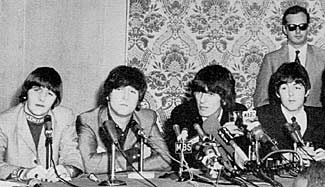
News conference at the Warwick Hotel.
Found at http://www.beatlesinterviews.org/.
Copyright owner unknown.
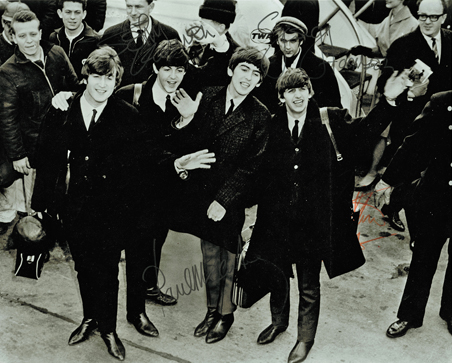
Autographed glossy given to Gisa during the flight.
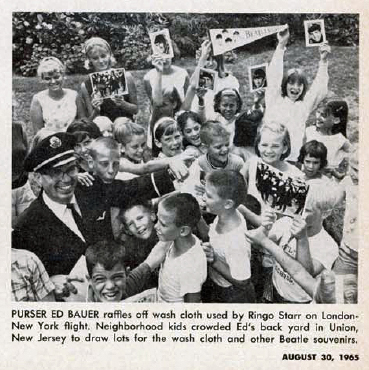
From the Skyliner article about The Beatles' TWA flight.
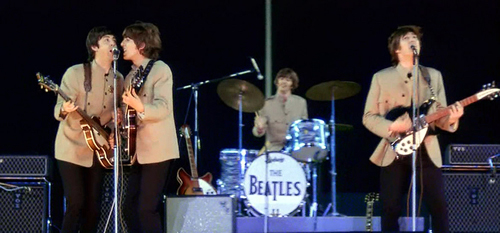
On-stage at Shea Stadium, August 15, 1965.
Copyright holder unknown.
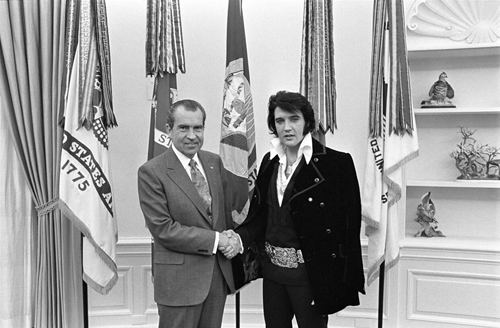
December 21, 1970.
Return to top of page.
Return to
tswrites.com.